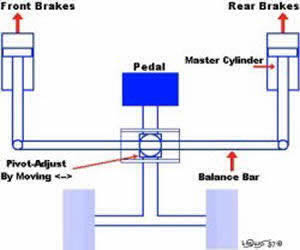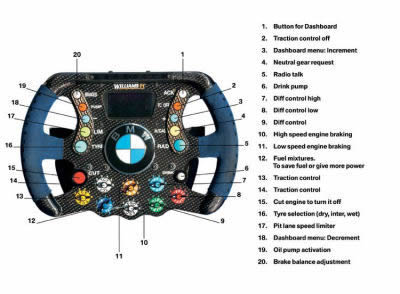Brake Balance or Brake Bias
Adjustable by the driver in the cockpit via a dial located on the steering wheel. Establishes the ratio of braking force between the front and rear wheels brakes.
One of the most important adjustments that a driver has to make to a car while running is brake balance. Brake balance, called also brake bias, front to rear, is critical to the stability of a racing car during the braking and during turn-in phase; too much rear brakes will tend to cause the car to spin; too much front and car will not turn in. Settings will change as the fuel load lightens, the track grip changes, and particularly if it rains. This setting is so critical that is impossible to race engineer to determine it. Driver must set it up by feeling.
Lets see it little bit closer.
When a Formula 1 driver lifts his foot off the accelerator pedal at 300kph, without touching brake pedal, his race car will slow at rate of over 2 g just due to the aerodynamic drag. This contrasts with braking force of 1.0g to 1.5g for the best sports cars (the Bugatti Veyron is claimed to be able to break at 1.3 g) during actual braking - using brake pedal. An F1 car can brake from 200 km/h to a complete stop just 2.9 seconds, using only 65 meters. By the time driver has put his foot on the brake pedal, and the brakes have heated up to their working temperature, the car will slowed by 200kph and the brakes will add around 4 g to the effort to slow the car, instantaneously absorbing over 2500hp. Just over 2 seconds later, he will be travelling at 100kph (60mph), and ready to ease off the brake pedal as he approaches the apex to the second gear corner ahead. During these frantic couple of seconds, apart from changing down four gears, the driver must modulate the load on the brake pedal to reduce the braking as the aerodynamic downforce comes off the car, and to make sure that the balance does not change too much and destabilise it. And he might, just possibly, overtake another car while all of this is going on.
These one or two seconds, as the Grand Prix driver slows his car and sets it up for entering corner, are probably his busiest periods in a complete lap. It is these moments that distinguish the great drivers from the merely good.
The deceleration forces work against the natural stability of the vehicle, making it want to swap ends just as he turns in. Drivers inevitably complain most about the performance and characteristics of the car under braking, and a lot of incidents, when control is finally lost, occur in the braking phase.
It is not surprising that designers seek to provide the most sophisticated controls and control systems that they can devise, within the regulations, to assist the driver to get the most out of his car under braking.
We know that percentage of vertical load on the front axle varies with speed, as well as the braking g-force level. The g-level has to fall with speed as the aerodynamic downforce reduces with the square of the speed. Provided that the aerodynamic distribution is nearly the same as the weight distribution and does not change much with car ride height, then the main contribution to the changing front axle g-level percentage is due to weight transfer. Around 10% of the retardation force is transferred from the rear axle to the front during deceleration. As speed reduces, the retardation force falls and the balance changes towards the rear. In reality, most Formula 1 cars have aerodynamic configurations that move the aerodynamic balance towards the front as the ride height reduces and the car pitches nose-down. The shift in load distribution towards the rear will be more pronounced as the speed falls.

Two independent brake circuits
Formula 1 cars and indeed all race cars, have two independent brake circuits (front and rear) which come together at the brake pedal. A pivot on the pedal apportions pedal load to the twin master cylinders, according to the position of the pivot on the crossbar that links the pedal to the master cylinder pistons.
Because the setup of the brake balance between front and rear is so important to the stability of the car under braking and turn-in, it is left up to the driver to adjust the balance while driving. Mechanism to move the pivot point, via a cockpit-mounted control lever or knob, permit fine adjustments to be made to the balance, compensating for changes in track condition, fuel load, tire conditions and driver preference. However, it is beyond the capabilities of even the finest drivers to make such adjustments while actually braking to compensate for the changes in vertical load distribution.
For years the driver has been able to adjust the balance by rotating a knob in the cockpit, driving a flexible cable that moves the pedal pivot to a new position on the balance bar. Such a system requires the driver to reach down into the cockpit, usually with his left hand, and turn the knob.
Today, to adjust brake balance from the steering wheel requires an electronically controlled servo-system. Rule that must be adhered to is that it must not be possible to make adjustments while the brakes are applied - that would be a sort of active brake balance and that is forbidden by FIA rules. A knob, with several numbered switch positions or some other system is used for brake balance adjustment. All the teams have their own systems, about which they are very secretive, that change the brake bias from front to rear as the downforce bleeds off the car as it slows down during braking.

20 - brake balance adjustment
At the middle of 2013, an updated version of Formula 1's 2014 technical regulations has been issued. As part of the new powertrain regulations, a large part of the cars' power will be provided by energy recovery systems.
What was termed KERS is now ERS-K and has effectively double the power output, for five times longer, than current systems.
Harvesting this much energy under braking will affect the braking effect at the rear wheels, so an electronic rear brake control system will be allowed. This will be used to offset the ERS-K effect by aiding the braking effort at the rear, negating the need for the driver to constantly alter the brake bias.






